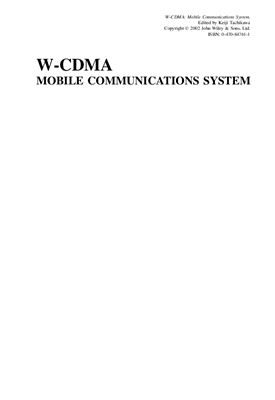Overview briefly reviews various cellular systems, ranging from
analog to digital, describes their characteristics and discusses
the objectives of IMT-2000 and the status of standardization.
Radio Transmission Systems explains, in an easyto-understand manner, the mechanism and the characteristics of CDMA as discussed in this volume with respect to radio access systems, a basic technology that is vital for mobile communications. It also describes basic transmission technologies such as cell search technologies, transmission power control technologies and diversity technologies, in addition to capacity-enhancement technologies based on adaptive array antennas.
Radio Systems provides a detailed explanation of radio access interfaces and radio system designs that form the basis of W-CDMA technology, as well as an introduction to mobile terminals.
Network Technologies reviews in detail ATM technologies, packet communication systems and other types of network systems.
Operation System gives an outline of network monitoring/control and equipment
monitoring/administration.
Multimedia Processing Methods describes in detail the processing schemes for multimedia signals including audio and video adopted in radio systems, information distribution schemes, location information processing and electronic authentication systems.
Future Prospects provides an outlook on the future directions of radio technologies, network technologies and signal processing technologies.
This volume was written by NTT DoCoMo’s engineers working at the forefront of research and development of W-CDMA. Much consideration was given to ensure that the descriptions are sufficiently covered and consistent. It was written to enable a wide range of readers to gain a general understanding of W-CDMA, with researchers, developers and operators in the mobile communications sector in mind, as well as students and end users.
Radio Transmission Systems explains, in an easyto-understand manner, the mechanism and the characteristics of CDMA as discussed in this volume with respect to radio access systems, a basic technology that is vital for mobile communications. It also describes basic transmission technologies such as cell search technologies, transmission power control technologies and diversity technologies, in addition to capacity-enhancement technologies based on adaptive array antennas.
Radio Systems provides a detailed explanation of radio access interfaces and radio system designs that form the basis of W-CDMA technology, as well as an introduction to mobile terminals.
Network Technologies reviews in detail ATM technologies, packet communication systems and other types of network systems.
Operation System gives an outline of network monitoring/control and equipment
monitoring/administration.
Multimedia Processing Methods describes in detail the processing schemes for multimedia signals including audio and video adopted in radio systems, information distribution schemes, location information processing and electronic authentication systems.
Future Prospects provides an outlook on the future directions of radio technologies, network technologies and signal processing technologies.
This volume was written by NTT DoCoMo’s engineers working at the forefront of research and development of W-CDMA. Much consideration was given to ensure that the descriptions are sufficiently covered and consistent. It was written to enable a wide range of readers to gain a general understanding of W-CDMA, with researchers, developers and operators in the mobile communications sector in mind, as well as students and end users.

